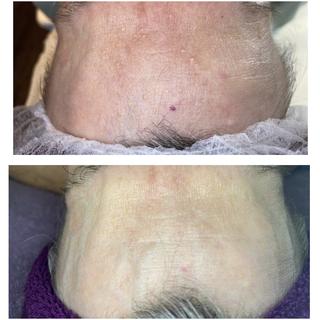Milia
Are you looking for someone who can remove milia?
Milia cysts are often referred to as milia seeds, oil seeds and whiteheads. They are mostly associated with dry skin and lie underneath the top layer of skin, very close to the surface. Milia are made up of keratin and usually occur on the cheeks, close to the eyes and on the eyelids. They present as tiny, white, rounded hard lumps.
Squeezing milia isn’t particularly successful and can often result in scarring.
Milia are not contagious and do not pose any health risk.
Milia can be easily treated using advanced electrolysis. It is very effective and can significantly improve the condition of your skin and increase your confidence as result.
How does it work?
I work in a very precise manner, using an advanced electrolysis technique. A very tiny needle emitting a diathermy current is applied to each milia individually. This results in the milia breaking down and dispersing. The surrounding skin is untouched and once healed there is no trace that the milia was there.

How many sessions will I need to have?
This will depend on a few factors. Mainly:
- how many milia are present
- how far apart the milia are
- how large the milia are
- how long the milia have been present (older milia will be harder and this will affect how easily they can be removed)
- how well your skin heals
- how well you follow the aftercare instructions
How often can I have a session?
A minimum of four weeks must be left between each treatment session to ensure full healing each time.
Is the treatment painful?
This is not a sensation-free treatment and there is some discomfort involved! It is best described as a hot pin-prick. The level of sensation does vary from one individual to another. My best advice would be to relax! If you are relaxed you are likely to experience less discomfort than if you are nervous and tense. You may also find the treatment more uncomfortable if you are tired, unwell or during certain times of your menstrual cycle.
Are the results painful?
Milia is associated with dry skin. If you have a predisposition to milia, ongoing treatments may be necessary as new milia can form.
Milia are also linked to the use of skincare products which are too rich, strong, abrasive or unsuitable for your skin type. I will review your skincare routine as part of your consultation and advise accordingly.
There has been some research as to whether there is a correlation between the occurrence of milia and high levels of cholesterol in the diet. The results on this are divided!
Excessive vitamin C consumption is also an associated cause.
What is the aftercare involved?
Immediately after the treatment, the skin will normally appear pink/red, warm and possibly slightly swollen. Over the following 48 hours tiny healing crusts will form. No cleanser or make-up should be used during the first 48 hours. During the first 48 hours you will need to avoid the following:
- touching the area
- alcohol
- exercise
- anything which causes sweating (saunas, steam rooms etc)
Once formed the healing crusts must be kept as dry as possible and must not be knocked or picked off. They will naturally lift off after 5-7 days. Early removal of the healing crusts can delay healing and can negate the treatment.
You will be best advised to plan your treatment sessions into your schedule when you have a few days to allow the initial healing to take place. This is not a treatment to have immediately before a big occasion.
Once the healing crusts have fallen off, good quality SPF50 or SPF40 must be used on the treated area for at least 6 weeks. Actively sunbathing must be avoided. If you’ve read any of my blogs you’ve probably gathered that I am a huge advocate for wearing SPF daily, all year round. SPF really is your BFF!
Are there any medical conditions that would prevent me from being suitable for this treatment?
Yes. At your consultation and initial assessment, we would check for any medical conditions that would prevent us from going ahead with the treatment. To prevent you a wasted the journey the following conditions would mean you are unsuitable:
- cochlear implants
- history of keloid scarring
- haemophilia
- pacemaker
- taking blood thinning medication (Warfarin or aspirin)
- diabetes
- epilepsy
- high blood pressure
- any vascular or circulatory disorders
- recent suntan (you will need to wait until it has faded)
- recent scar tissue in the area to be treated
- use of retinol, Retin A or tretinoin on the area to be treated
It is vital for effective and safe treatment that you are honest when answering the questions at your consultation.
What is the cost of this treatment?
If your milia are numerous and close together it will not be possible to treat them all in one session as the area would become overworked.
We can work on one area for up to 15 minutes before moving onto the next area. For example, each cheek would class as one area so we could work on each cheek for up to 15 minutes before moving to the other side.
| Up to 15 minutes | £65.00 |
| Up to 30 minutes | £130.00 |
Image Credit Schwarzkopf Professional
© John and Associates 2025.
An iCreate website, part of iSalon Software
Privacy PolicyCookie PolicyDisclaimerAccessibilityLate Cancellation PolicyNo Show PolicyLate Arrival PolicyService GuaranteeHealth History PolicyRight To Refuse ServiceChildren In The SalonMobile Phones In The SalonInclusivity StatementColour-responsible-policy
Icons by Font Awesome, Pixeden, Flaticon.
Hair dressing icons by Freepik, SmashIcons via Flaticon.